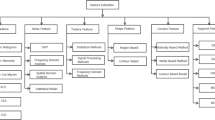Abstract
Fast Hartley transform (FHT) is an integral transform which shares some features with the Fourier transform. Fourier transform is used successfully in computing the Fourier descriptors which are used in the recognition of characters and objects. In this paper, printed Arabic optical character recognition using Hartley transform is presented. The Hartley descriptors are estimated by applying the FHT to the Arabic printed characters. The contour of the Arabic character primary part is extracted and then FHT is applied to the extracted contours. Hartley features are extracted from the FHT domain. These features are used for the recognition of Arabic characters. It was experimentally proven that the use of 10–20 descriptors gives the best recognition rate. Hence, ten descriptors were used to save computation and processing times. Experimental results using ten Hartley descriptors resulted in a recognition rate of 97% and an error rate of 3%. Arabic characters’ dots and holes were used in addition to the ten Hartley descriptors to enhance the recognition rate. The use of these features resulted in a 97.3 recognition rate, 2% rejection rate, and 0.7% error rate. The dot feature was also used to reduce the number of classes of the Arabic characters without affecting the recognition rate or the number of recognized characters. This technique, based on Hartley descriptors, was compared with the Fourier descriptors calculated from the fast Fourier transform (FFT) and with modified Fourier spectrum (MFS) descriptors. Experimental results have shown that the Hartley descriptors are comparable to the FFT-based Fourier descriptors in terms of recognition rate. The Hartley and FFT-based descriptors are better than the MFS descriptors in terms of recognition rate.








Similar content being viewed by others
References
Al-Badr B, Mahmoud SA (1995) Survey and bibliography of Arabic optical text recognition. J Signal Processing 41(1):49–77
Govindan VK, Shivaprasad AP (1990) Character recognition—a review. Pattern Recognit 23(7):671–683
Mantas J (1986) An overview of character recognition methodologies. Pattern Recognit 19(6):425–430
McClell D (1991) OCR: teaching your Mac to read. Macworld, pp 169–178
Elisa M, Welch VR, (1993) Can you read this? OCR Software. MacUser 9(8):169–178
Mori S, Suen CY, Yamamoto K (1992) Historical review of OCR research and development. Proc IEEE 80(7):1029–1057
Impedovo S, Ottaviano L, Occhinegro S (1991) Optical character recognition a survey. Int J Pattern Recognit Artif Intell 5(1):1–24
Jain AK, Duin RPW, Mao J (2000) Statistical pattern recognition: a review. IEEE Trans Pattern Anal Mach Intell 22(1):4–37
Plamondon R, Srihari SN (2000) On-line and off-line handwriting recognition: a comprehensive survey. IEEE Trans Pattern Anal Mach Intell 22(1):63–82
Liu CL, Jaeger S, Nakagawa M (2004) Online recognition of chinese characters: the state-of-the-art. IEEE Trans Pattern Anal Mach Intell 26(2):198–213
Nabawi A, Mahmoud S (2000) Arabic optical text recognition: a classified bibliography. Eng Res Bull Minufiyah University Egypt 23(1):79–131
Khorsheed M (2002) Off-line Arabic character recognition–a review. Pattern Anal Appl 5:31–45
Lorigo LM, Govindaraju V (2006) Offline Arabic handwriting recognition: a survey. IEEE Trans Pattern Anal Mach Intell 28(5):712–724
Sarfraz M, Nawaz SN, Al-Khuraidly A, (2003) Offline Arabic text recognition system. The Proceedings of IEEE International Conference on Geometric Modeling and Graphics-GMAG’2003-UK, IEEE Computer Society Press, USA
Sarfraz M, Shahab SA (2005) An efficient scheme for tilt correction in Arabic OCR system. In: Sarfraz M, Wang Y, Banissi E (eds) Computer Graphics, Imaging and Visualization—New Trends, ISBN: 3–7695–2392–7, IEEE Computer Society, USA, pp 379–384
Zidouri A, Sarfraz M, Shahab SA, Jafri SM (2005) Adaptive dissection based subword segmentation of printed Arabic text. The proceedings of IEEE international conference on information visualisation (IV’2005)-UK, IEEE Computer Society Press, pp 991–996
Kherallah M, Rokbani N, Alimi AM (2005) Global recognition of the Arabic words by genetic algorithm and visual encoding, 17th IMACS World Congress Scientific Computing, Applied Mathematics and Simulation (IMACS’2005)
Sameh T, Ben AN, Ham A (2005) Arabic handwritten words recognition based on a planar hidden markov model. Int Arab J Inf Technol 2(4):318–325
Almaadeed S, Higgens C, Elliman D (2001) A new preprocessing system for the recognition of off-line handwritten arabic words.IEEE Int Symp Signal Process Inf Technol, December
Almaadeed S, Higgens C, Elliman D (2002) Recognition of off-line handwritten arabic words using hidden markov model approach. ICPR 2002, Quebec City
Almaadeed S, Higgens C, Elliman D (2004) Off-line recognition of handwritten Arabic words using multiple hidden Markov models. Knowl Based Syst 17:75–79
Dehghan M, Faez K, Ahmadi M, Shridhar M (2001) Handwritten Farsi (Arabic) word recognition: a holistic approach using discrete HMM. Pattern Recognit 34:1057–1065
Bazzi I, Schwartz R, Makhoul J (1999) An omifont open-vocabulary OCR system for English and Arabic. IEEE Trans PAMI 21(6):495–504
Mahmoud SA (1991) Motion estimation based on modified Fourier spectrum. Inf Process Lett 37:311–313
Mahmoud SA (1991) Use of Fourier and Hartley transforms in motion analysis: a comparative study. Int J Imaging Syst Technol 3:311–317
Hou HS (1987) The fast Hartley transform algorithm. IEEE Trans Comput C 36(2):147–156
Bracewell RN (1983) Discrete Hartley transform. J Opt Soc Am 73(12):1832–1835
Duhamel P (1986) Implementation of split-radix FFT algorithms for complex, real, and real symmetric data. IEEE Transactions on ASSP, vol. ASSP–34, no.2
Mahmoud SA (1994) Arabic character recognition using Fourier descriptors and character contour encoding. Pattern Recognit 27(6):815–824
Acknowledgments
We are grateful for the constructive criticism and stimulating remarks made by the referees. The modification of the original manuscript to address those remarks improved the revised manuscript considerably. In addition, we would like to thank King Fahd University of Petroleum and Minerals for supporting this research work and providing the computing facilities.
Author information
Authors and Affiliations
Corresponding author
Rights and permissions
About this article
Cite this article
Mahmoud, S.A., Mahmoud, A.S. The use of Hartley transform in OCR with application to printed Arabic character recognition. Pattern Anal Applic 12, 353–365 (2009). https://doi.org/10.1007/s10044-008-0128-8
Received:
Accepted:
Published:
Issue Date:
DOI: https://doi.org/10.1007/s10044-008-0128-8




